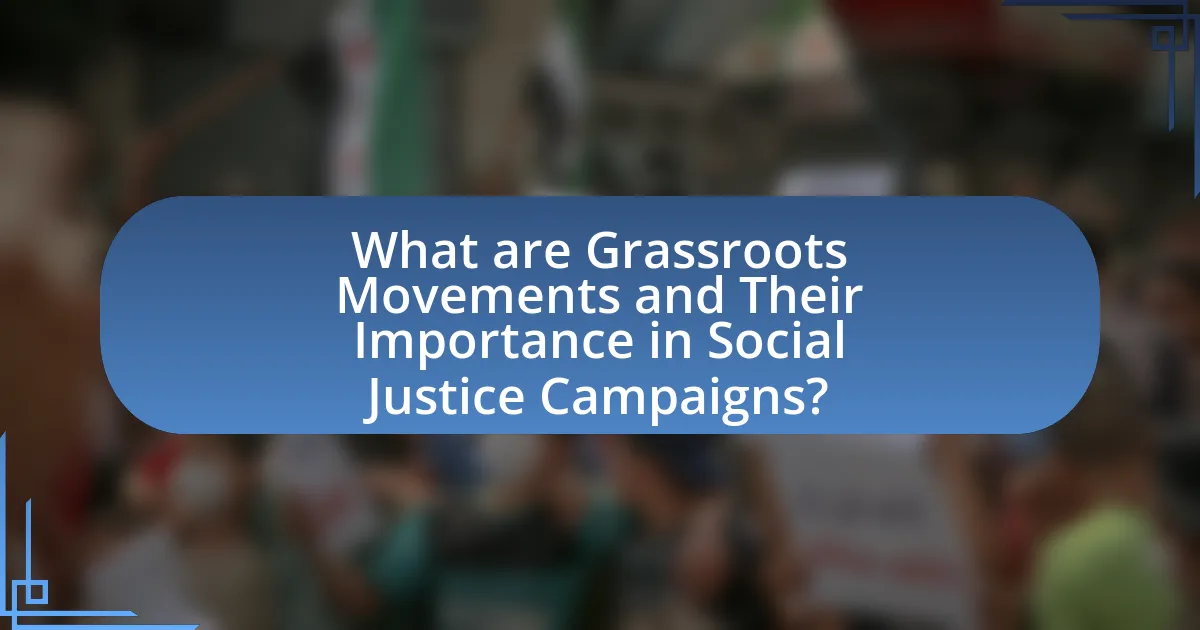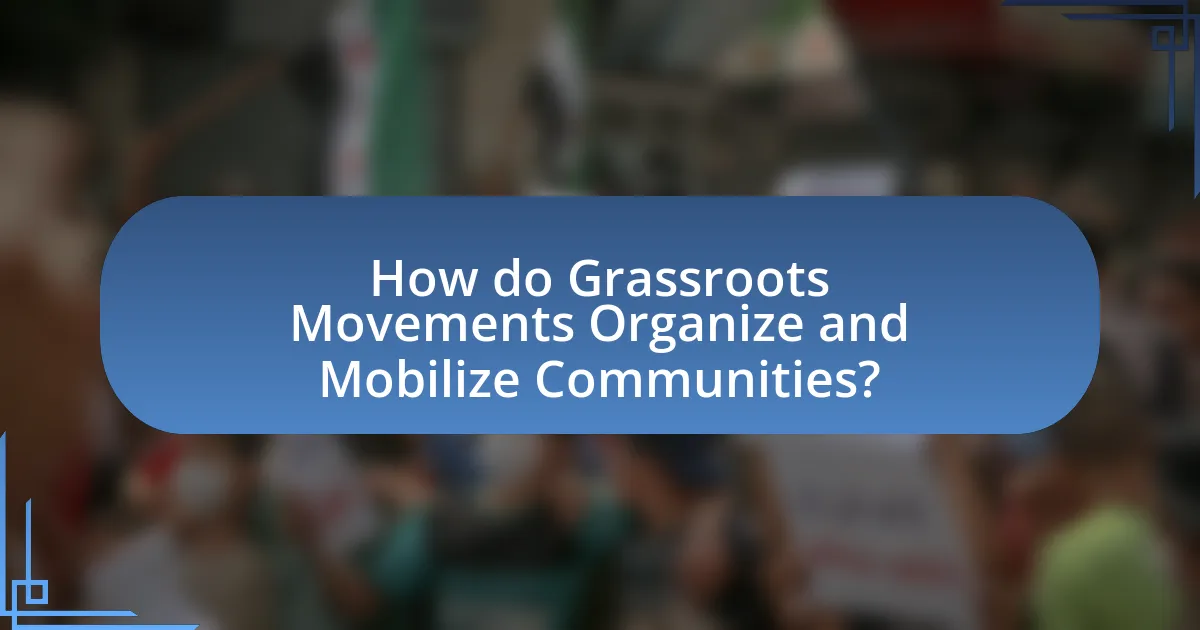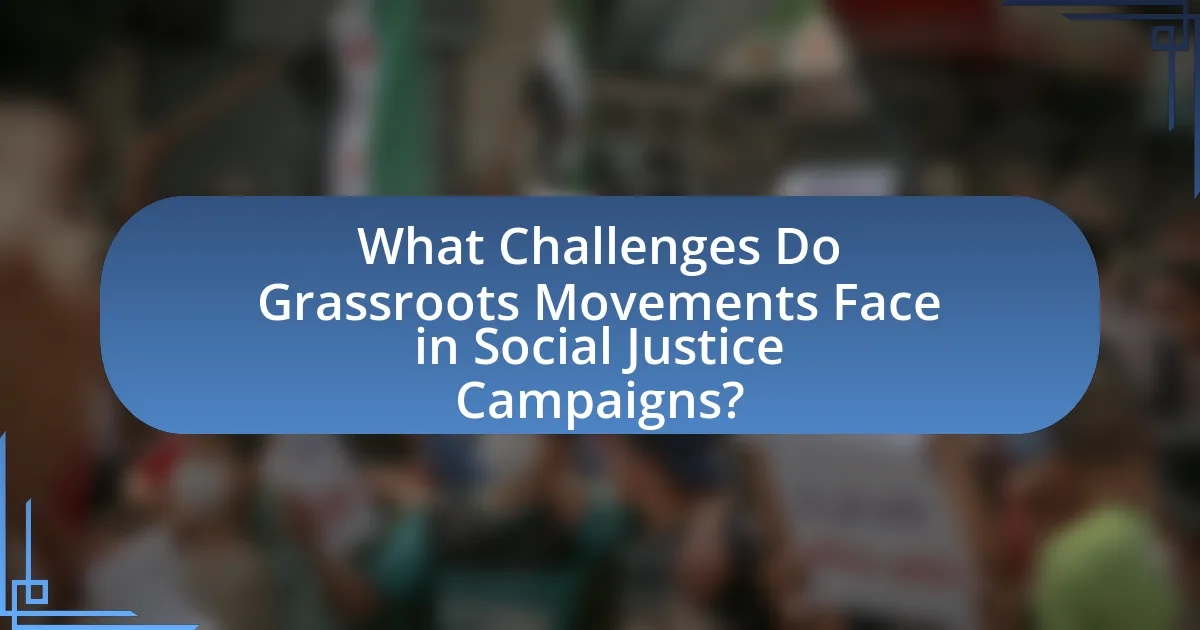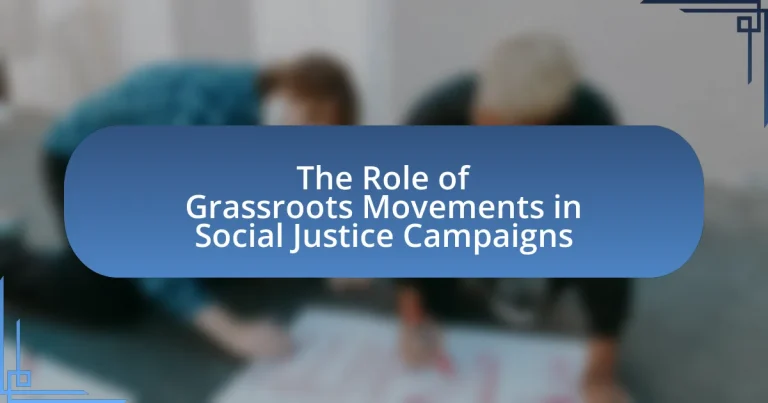Grassroots movements are organized efforts by ordinary individuals at the community level aimed at advocating for social change, particularly in areas such as civil rights, environmental justice, and economic equality. This article explores the significance of grassroots movements in social justice campaigns, highlighting their ability to mobilize communities, raise awareness, and influence policy through collective action. It distinguishes grassroots movements from traditional advocacy groups, outlines their defining characteristics, and examines historical examples that illustrate their impact, such as the Civil Rights Movement and the Women’s Suffrage Movement. Additionally, the article discusses the strategies grassroots movements employ to organize and mobilize communities, the challenges they face, and best practices for ensuring inclusivity and measuring their impact.

What are Grassroots Movements and Their Importance in Social Justice Campaigns?
Grassroots movements are organized efforts by ordinary people at the community level to advocate for social change, often focusing on issues like civil rights, environmental justice, and economic equality. Their importance in social justice campaigns lies in their ability to mobilize individuals, raise awareness, and influence policy through collective action. For example, the Civil Rights Movement in the United States, which included grassroots organizations like the Student Nonviolent Coordinating Committee, successfully challenged systemic racism and led to significant legislative changes, such as the Civil Rights Act of 1964. This demonstrates that grassroots movements can effectively drive social justice initiatives by empowering marginalized voices and fostering community engagement.
How do grassroots movements differ from traditional advocacy groups?
Grassroots movements differ from traditional advocacy groups primarily in their structure and approach to mobilization. Grassroots movements are typically community-driven, relying on local participation and collective action to address social issues, whereas traditional advocacy groups often operate through established organizations with formal leadership and structured campaigns. For example, grassroots movements like the Black Lives Matter movement emerged organically from community activism, emphasizing direct action and local engagement, while traditional advocacy groups such as the American Civil Liberties Union (ACLU) utilize formal lobbying and legal strategies to influence policy. This distinction highlights how grassroots movements prioritize grassroots participation and community empowerment, contrasting with the top-down approach often seen in traditional advocacy organizations.
What characteristics define grassroots movements?
Grassroots movements are characterized by their community-driven nature, emphasizing local participation and leadership. These movements typically arise from the collective efforts of individuals at the local level who seek to address specific social, political, or environmental issues. They often rely on volunteer efforts, grassroots organizing, and mobilization of community members to effect change. Evidence of their effectiveness can be seen in historical examples such as the Civil Rights Movement, where local activists played crucial roles in organizing protests and advocating for policy changes. Additionally, grassroots movements often utilize social media and digital platforms to amplify their message and engage a broader audience, demonstrating their adaptability in modern contexts.
Why are grassroots movements essential for social change?
Grassroots movements are essential for social change because they empower individuals at the community level to advocate for their rights and influence policy. These movements often arise from the collective experiences and needs of marginalized groups, enabling them to mobilize resources, raise awareness, and create pressure for systemic change. Historical examples, such as the Civil Rights Movement in the United States, demonstrate how grassroots organizing led to significant legislative reforms, including the Civil Rights Act of 1964, which outlawed discrimination based on race, color, religion, sex, or national origin. This illustrates that grassroots movements not only amplify voices but also drive tangible social and political transformations.
What historical examples illustrate the impact of grassroots movements?
Grassroots movements have significantly influenced social change throughout history, with notable examples including the Civil Rights Movement in the United States and the anti-apartheid movement in South Africa. The Civil Rights Movement, particularly from the 1950s to the 1960s, mobilized ordinary citizens to challenge racial segregation and discrimination, leading to landmark legislation such as the Civil Rights Act of 1964 and the Voting Rights Act of 1965. This movement was characterized by grassroots organizations like the Student Nonviolent Coordinating Committee (SNCC) and the Southern Christian Leadership Conference (SCLC), which organized protests, sit-ins, and voter registration drives.
Similarly, the anti-apartheid movement in South Africa, which gained momentum in the 1980s, was driven by grassroots activism that united various groups against racial oppression. Organizations like the African National Congress (ANC) and the United Democratic Front (UDF) mobilized citizens to engage in protests, strikes, and international advocacy, ultimately contributing to the dismantling of apartheid and the election of Nelson Mandela in 1994. These examples illustrate how grassroots movements can effectively challenge systemic injustices and bring about significant legislative and societal changes.
How did grassroots movements contribute to the Civil Rights Movement?
Grassroots movements significantly contributed to the Civil Rights Movement by mobilizing local communities to advocate for racial equality and social justice. These movements, such as the Student Nonviolent Coordinating Committee (SNCC) and the Southern Christian Leadership Conference (SCLC), organized protests, voter registration drives, and community education initiatives. For example, the SNCC played a crucial role in the Freedom Rides and the Mississippi Freedom Summer, which aimed to increase voter registration among African Americans in the South. Their efforts led to the passage of the Voting Rights Act of 1965, which aimed to eliminate barriers to voting for African Americans. Grassroots activism not only raised awareness about civil rights issues but also empowered individuals to take action, creating a widespread demand for change that was essential to the movement’s success.
What role did grassroots activism play in the Women’s Suffrage Movement?
Grassroots activism was crucial in the Women’s Suffrage Movement as it mobilized local communities to advocate for women’s voting rights. Activists organized rallies, petitions, and educational campaigns, effectively raising awareness and building public support. For instance, the National American Woman Suffrage Association (NAWSA) utilized grassroots strategies to engage women across the nation, leading to significant milestones such as the passage of the 19th Amendment in 1920, which granted women the right to vote. This grassroots involvement demonstrated the power of collective action and local engagement in achieving social and political change.

How do Grassroots Movements Organize and Mobilize Communities?
Grassroots movements organize and mobilize communities through community engagement, coalition building, and strategic communication. These movements often begin by identifying local issues that resonate with community members, fostering a sense of shared purpose. For instance, the Black Lives Matter movement effectively mobilized communities by addressing systemic racism and police violence, utilizing social media to spread awareness and encourage participation in protests.
Additionally, grassroots organizations often form coalitions with other local groups to amplify their efforts, pooling resources and expertise to create a more significant impact. Research shows that grassroots campaigns that engage in face-to-face interactions, such as town hall meetings or community forums, significantly increase participation rates and foster a stronger sense of community ownership over the issues at hand.
Moreover, effective communication strategies, including storytelling and the use of relatable messaging, help to inspire action and solidarity among community members. The success of grassroots movements in mobilizing communities is evidenced by their ability to influence policy changes and raise public awareness on critical social justice issues.
What strategies do grassroots movements use to engage community members?
Grassroots movements engage community members through strategies such as community organizing, direct action, and participatory decision-making. Community organizing involves mobilizing individuals to identify shared issues and work collectively towards solutions, fostering a sense of ownership and empowerment. Direct action, including protests and demonstrations, raises awareness and galvanizes support for specific causes, effectively drawing attention to injustices. Participatory decision-making encourages community input in planning and executing initiatives, ensuring that the voices of community members are heard and valued. These strategies have been shown to enhance community involvement and strengthen social ties, as evidenced by successful campaigns like the Civil Rights Movement, which utilized grassroots tactics to achieve significant legislative changes.
How do grassroots movements utilize social media for mobilization?
Grassroots movements utilize social media for mobilization by creating platforms for communication, organizing events, and spreading awareness rapidly. These movements leverage social media’s wide reach to connect with supporters, share information, and coordinate actions, often resulting in significant participation and engagement. For instance, the Black Lives Matter movement effectively used Twitter and Facebook to organize protests and disseminate information about police brutality, leading to widespread global demonstrations in 2020. This demonstrates how social media can amplify grassroots efforts, allowing for real-time updates and fostering community solidarity.
What role do local events and meetings play in grassroots organization?
Local events and meetings are crucial for grassroots organization as they facilitate community engagement and mobilization. These gatherings provide a platform for individuals to connect, share ideas, and strategize collective actions, fostering a sense of belonging and shared purpose. Research indicates that grassroots movements often rely on face-to-face interactions to build trust and solidarity among participants, which enhances their effectiveness in advocating for social justice. For instance, the 2011 Occupy Wall Street movement utilized local assemblies to organize and empower individuals, demonstrating how such events can galvanize support and drive social change.
How do grassroots movements build coalitions with other organizations?
Grassroots movements build coalitions with other organizations by establishing shared goals and fostering mutual trust. These movements often identify common interests with potential partners, which can include non-profits, community groups, and advocacy organizations. By engaging in open dialogue and collaborative planning, grassroots movements create a foundation for joint initiatives. For example, the Black Lives Matter movement has successfully partnered with various organizations to address systemic racism, demonstrating the effectiveness of coalition-building in amplifying their message and resources. This collaborative approach not only strengthens the movements but also enhances their impact on social justice campaigns.
What are the benefits of coalition-building for grassroots movements?
Coalition-building significantly enhances grassroots movements by amplifying their collective voice and increasing their resources. When grassroots organizations unite, they can share knowledge, strategies, and networks, which leads to more effective advocacy and mobilization efforts. For instance, the collaboration between various civil rights groups during the 1960s, such as the Southern Christian Leadership Conference and the Student Nonviolent Coordinating Committee, demonstrated how coalition-building can lead to impactful social change, culminating in landmark legislation like the Civil Rights Act of 1964. Additionally, coalitions can attract broader public attention and media coverage, which is crucial for raising awareness and support for their causes.
How can grassroots movements effectively collaborate with larger organizations?
Grassroots movements can effectively collaborate with larger organizations by establishing clear communication channels and aligning their goals. This collaboration allows grassroots movements to leverage the resources, networks, and influence of larger organizations while maintaining their grassroots identity. For example, the collaboration between the Black Lives Matter movement and established civil rights organizations has amplified advocacy efforts, resulting in significant policy changes and increased public awareness. Such partnerships can enhance the reach and impact of social justice campaigns, as evidenced by the successful mobilization of resources during the Women’s March in 2017, where grassroots organizers worked alongside larger feminist organizations to unite diverse groups for a common cause.

What Challenges Do Grassroots Movements Face in Social Justice Campaigns?
Grassroots movements face significant challenges in social justice campaigns, including limited funding, lack of media coverage, and internal divisions. Limited funding restricts their ability to mobilize resources effectively, as many rely on small donations and volunteer efforts rather than substantial financial backing. Lack of media coverage often leads to insufficient public awareness and support, making it difficult for these movements to gain traction. Internal divisions can arise from differing priorities and strategies among members, which can hinder cohesive action and dilute their impact. These challenges collectively impede the effectiveness of grassroots movements in achieving their social justice goals.
What obstacles do grassroots movements encounter in their efforts?
Grassroots movements encounter several obstacles in their efforts, including limited funding, lack of media coverage, and internal conflicts. Limited funding restricts their ability to organize events, mobilize supporters, and sustain long-term campaigns, as many rely on small donations and volunteer efforts. Lack of media coverage often leads to insufficient public awareness and support, making it difficult for these movements to gain traction and influence policy. Internal conflicts can arise from differing priorities and strategies among members, which can hinder decision-making and weaken the overall effectiveness of the movement. These challenges are documented in studies such as “The Challenges of Grassroots Movements” by the Institute for Social Change, which highlights the systemic barriers faced by these organizations in achieving their goals.
How do funding and resource limitations affect grassroots initiatives?
Funding and resource limitations significantly hinder grassroots initiatives by restricting their operational capacity and outreach. Limited financial support often results in fewer resources for organizing events, mobilizing volunteers, and executing campaigns effectively. For instance, a study by the Grassroots Fundraising Journal indicates that grassroots organizations with annual budgets under $100,000 struggle to maintain staff and sustain long-term projects, leading to decreased community impact and engagement. Consequently, these limitations can stifle innovation and reduce the ability to advocate for social justice effectively, as seen in various movements that rely heavily on community donations and volunteer efforts.
What challenges arise from political opposition to grassroots movements?
Political opposition to grassroots movements presents significant challenges, including repression of activism, loss of funding, and diminished public support. Repression can manifest through legal actions, surveillance, or violence against activists, which stifles their ability to organize and mobilize effectively. For instance, in the United States, the FBI has historically monitored and infiltrated grassroots organizations, such as the Civil Rights Movement, to undermine their efforts. Additionally, political opposition can lead to the withdrawal of financial support from donors who fear backlash, as seen in various environmental movements facing opposition from corporate interests. This financial strain can cripple grassroots initiatives, limiting their outreach and impact. Furthermore, sustained political opposition can create a narrative that delegitimizes grassroots movements, causing potential supporters to hesitate in joining or contributing, thereby weakening the movement’s overall influence and effectiveness.
How can grassroots movements overcome these challenges?
Grassroots movements can overcome challenges by leveraging community engagement, building coalitions, and utilizing digital platforms for outreach. Community engagement fosters local support and mobilizes individuals around shared goals, as seen in the Civil Rights Movement, where grassroots organizing was crucial for mobilizing protests and voter registration drives. Building coalitions with other organizations enhances resources and amplifies voices, exemplified by the Women’s March, which united diverse groups to advocate for women’s rights. Additionally, utilizing digital platforms allows grassroots movements to reach wider audiences quickly and efficiently, as demonstrated by the #BlackLivesMatter movement, which gained international attention through social media. These strategies collectively empower grassroots movements to navigate obstacles effectively.
What strategies can grassroots movements employ to secure funding?
Grassroots movements can employ several strategies to secure funding, including crowdfunding, grant applications, and building partnerships with local businesses. Crowdfunding platforms like GoFundMe and Kickstarter allow grassroots organizations to reach a wide audience and gather small contributions from many supporters, which can accumulate to significant amounts. Additionally, applying for grants from foundations that support social justice initiatives can provide substantial financial resources; for example, the Ford Foundation and the Open Society Foundations offer grants specifically for grassroots activism. Furthermore, establishing partnerships with local businesses can lead to sponsorships or in-kind donations, creating a mutually beneficial relationship that supports community engagement and funding. These strategies have been successfully utilized by various grassroots movements, demonstrating their effectiveness in securing necessary financial support.
How can grassroots movements effectively navigate political landscapes?
Grassroots movements can effectively navigate political landscapes by building strong community networks and leveraging local knowledge to influence policy. These movements often engage in grassroots organizing, which involves mobilizing community members to advocate for change, thereby creating a collective voice that can pressure political leaders. For instance, the Civil Rights Movement in the United States utilized local organizations to coordinate protests and voter registration drives, significantly impacting legislation such as the Voting Rights Act of 1965. Additionally, grassroots movements can utilize social media platforms to amplify their message and reach a broader audience, as seen in the #BlackLivesMatter movement, which gained international attention and influenced discussions on police reform. By combining local engagement with strategic communication, grassroots movements can effectively navigate and shape political landscapes.
What are the best practices for successful grassroots movements?
Successful grassroots movements prioritize community engagement, clear messaging, and strategic organization. Engaging the community fosters a sense of ownership and commitment, which is essential for mobilization. Clear messaging ensures that the goals and values of the movement resonate with a broader audience, making it easier to gain support. Strategic organization involves creating a structured plan that outlines roles, responsibilities, and timelines, which enhances efficiency and effectiveness.
Research indicates that grassroots movements that effectively utilize social media platforms can amplify their reach and impact. For instance, the Arab Spring demonstrated how social media facilitated rapid mobilization and coordination among activists, leading to significant political change. Additionally, studies show that movements with diverse coalitions tend to be more resilient and successful, as they can draw on a wider range of resources and perspectives.
How can grassroots movements ensure inclusivity and diversity in their campaigns?
Grassroots movements can ensure inclusivity and diversity in their campaigns by actively engaging diverse community members in the planning and decision-making processes. This engagement can be achieved through outreach efforts that prioritize underrepresented groups, ensuring their voices and perspectives are integral to the campaign’s objectives. Research indicates that inclusive campaigns are more effective; for instance, a study by the Stanford Social Innovation Review found that organizations that prioritize diversity in leadership and participation are better positioned to address complex social issues. By implementing strategies such as community forums, surveys, and partnerships with local organizations, grassroots movements can create a more equitable platform that reflects the diversity of the communities they serve.
What methods can grassroots movements use to measure their impact?
Grassroots movements can measure their impact through various methods, including surveys, social media analytics, and community feedback. Surveys allow organizations to gather quantitative data on participant experiences and changes in attitudes, while social media analytics provide insights into engagement levels and reach. Community feedback, obtained through forums or focus groups, offers qualitative data that reflects the movement’s influence on local issues. For instance, a study by the Stanford Social Innovation Review highlights that grassroots organizations often use pre- and post-campaign surveys to assess shifts in public opinion and policy changes, demonstrating the effectiveness of their efforts.

